News
Lab Analysis Detects Dangerous Metals From Duke Energy Coal Ash Spill
Posted on October 21st, 2016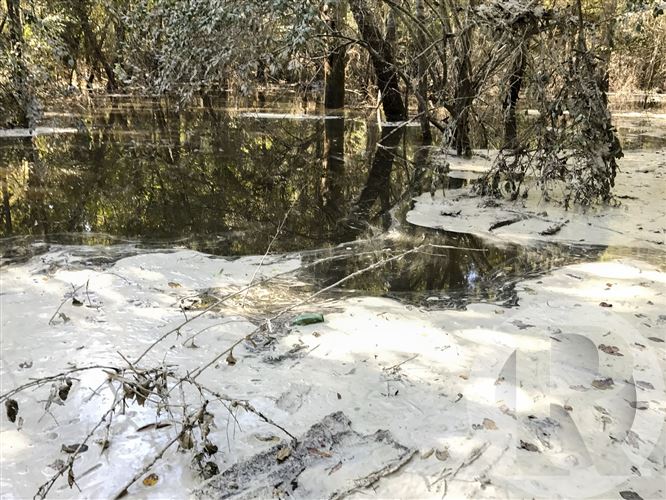
Coal ash spilled from Duke Energy HF Lee Facility discovered on the River by our Upper Neuse Riverkeeper
WATERKEEPER ALLIANCE / SOUND RIVERS UPDATE
LAB ANALYSIS DETECTS DANGEROUS METALS FROM DUKE ENERGY COAL ASH SPILL
Contact
Pete Harrison, Waterkeeper Alliance: pharrison@waterkeeper.org, 828-582-0422
Matthew Starr, Sound Rivers: upperneuserk@soundrivers.org, 919-961-2240
Update on lab results
Scientists at Appalachian State University used a scanning electron microscope (SEM) to visualize samples of the spilled coal ash cenospheres, and tested the particles for contaminants using Energy-dispersive X-ray spectroscopy (EDX). The EDX analysis detected dangerous heavy metals attached to the fly ash cenospheres, including antimony and cobalt. Duke Energy has previously reported elevated levels of both these contaminants in groundwater monitoring wells located around the inactive ash ponds where the coal ash spill occurred. Throughout the week, Duke Energy attempted to characterize cenospheres as “not coal ash” and “inert” and “not inherently toxic.” These talking points carefully avoid acknowledging what the EDX analysis confirms: the spilled coal ash cenospheres, though composed largely out of silica and aluminum, have more dangerous contaminants attached to them.
See a SEM image of the coal ash cenospheres here, and the EDX analytical result for one cenosphere here. Additional photos of the spill have been added to our photo album.
Chronology of coal ash spills at the HF Lee facility
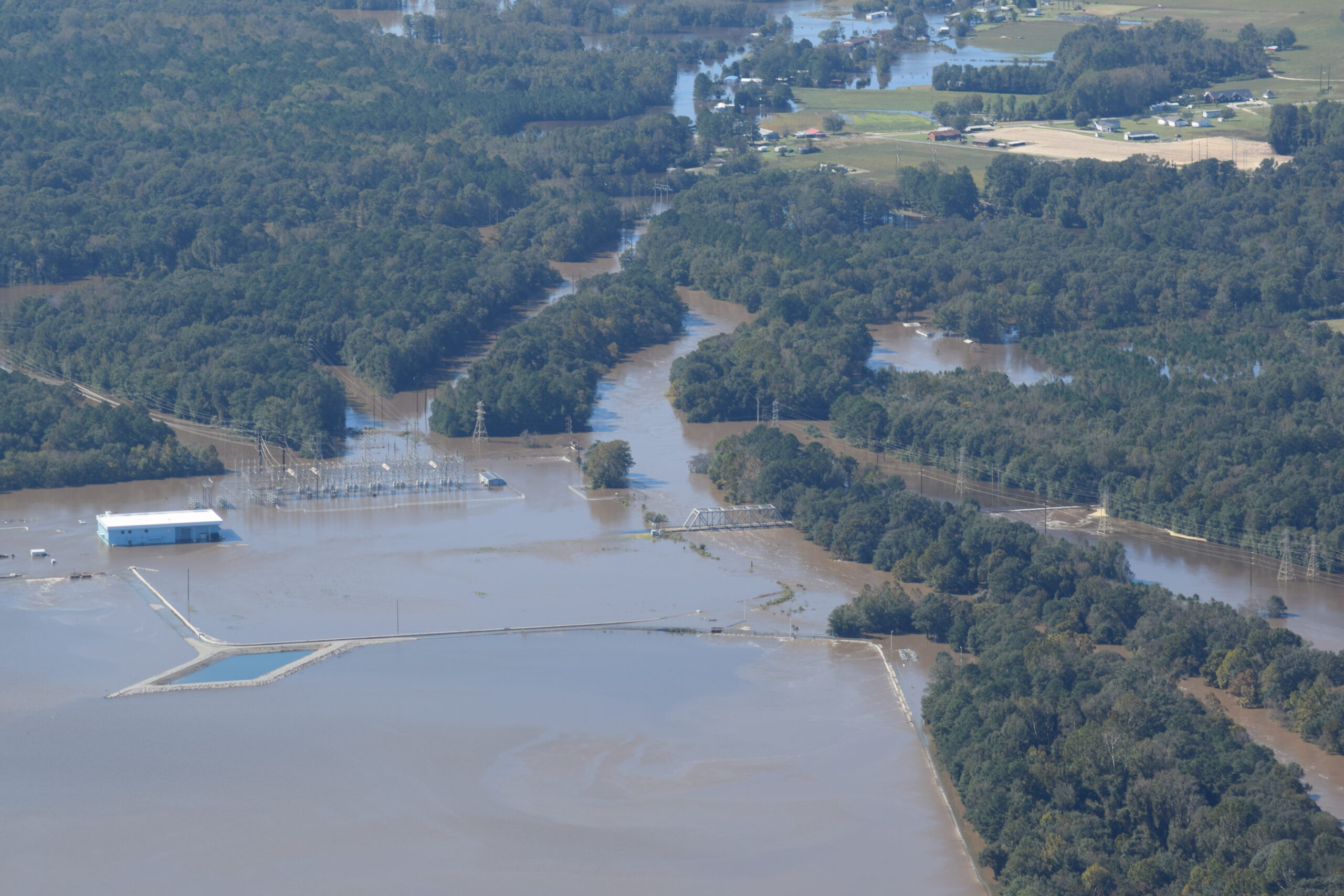
The record-breaking flood of Neuse River inundated three inactive coal ash ponds for five days last week. The flooded ponds are unlined and uncovered, containing more than a million tons of coal ash spread over 170 acres in a layer four to ten feet deep. On Friday, October 14 at 4:28 p.m., before the flood waters had completely receded from the flooded ash ponds, Duke Energy reported a spill of an undetermined amount of coal ash into the Neuse River to the U.S. Coast Guard’s National Response Center. On Saturday, Duke Energy and NC DEQ personnel inspected the inactive ash ponds by foot, claiming they “determined that the amount of material that was displaced would not even fill the bed of an average pickup truck.”
On Monday October 17, the flood waters had receded enough to allow us to launch a boat in the Neuse River to inspect for coal ash releases. Late Monday afternoon, the Upper Neuse Riverkeeper discovered a second coal ash spill coming from the inactive ash ponds at HF Lee. The coating of ash on tree branches high above the receding flood waters proved the spill had been ongoing for almost a week at that point.
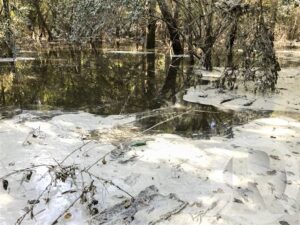
Duke Energy and DEQ both claim their representatives identified the second spill on Monday as well, independent of Waterkeeper Alliance’s public disclosure of the spill on Tuesday afternoon. We question the claim that both DEQ inspectors and Duke Energy staff traveled to the location of the second spill by boat on Monday and identified the white substance floating on the water and coating the trees. To the contrary, Duke Energy reportedly told WNCN on Tuesday evening that it had not yet conducted water sampling from a boat because state regulators had not deemed it safe to boat on the flooded river. This directly contradicts subsequent claims by Duke and DEQ that they had observed the spill by boat on Monday.
Since we exposed the second spill Tuesday afternoon, Duke Energy has continued to insist that the spilled material is “not coal ash,” falsely claiming that cenospheres are distinct from fly ash, the primary constituent of coal ash.
Waterkeeper Alliance attorney Pete Harrison called the mischaracterization “a shameful attempt by Duke Energy to trick the public and cover up a large coal ash spill that the company failed to identify and/or failed to report.” Duke Energy even acknowledges on its website (link and screenshot) that “cenospheres are a form of fly ash.” Duke’s failure to report the spill may have even been a violation of the company’s probation sentence, which it received last year after pleading guilty to federal crimes involving its mismanagement of coal ash at the H.F. Lee facility, among others.
Because Duke Energy did report a spill of coal ash on Friday (the purported pickup truck load), and the company has emphatically denied that the material discovered by the Upper Neuse Riverkeeper is coal ash, it is clear that material discovered in the river on Monday was a separate and distinct spill from the one Duke Energy reported on Friday. Based on currently available information, Duke Energy has still not reported the second spill to the National Response Center.
On Wednesday, the day after our organizations exposed the second coal ash spill, the NC DEQ claimed its “staff determined on Monday that material found at the H.F. Lee facility in Wayne County is not coal ash,” and accused Waterkeeper Alliance of “falsely reporting” the coal ash release. Both Duke and DEQ claimed, without analyzing the spilled material, that it was harmless cenospheres comprised of just aluminum and silica.
“After adopting Duke Energy’s indefensible position that the material was not coal ash and requiring no further action from Duke on Wednesday, DEQ has now done an about face, admitting last night that cenospheres are fly ash and ordering Duke to investigate the spills further,” commented Matthew Starr, Sound Rivers’ Upper Neuse Riverkeeper.
“The DEQ bureaucrats must have woken up yesterday with the embarrassing realization that the state Coal Ash Management Act they’re in charge of implementing defines cenospheres as coal ash,” said Donna Lisenby, Clean and Safe Energy Campaign Manager at Waterkeeper Alliance. (see page 4, definition 8). “Now DEQ seems to be changing its tune and agreeing with what we’ve been saying all along: Duke Energy is responsible for another coal ash spill into the Neuse River. Unfortunately this one looks like a lot more than a pickup-truck’s worth of ash was spilled,” said Lisenby.
“The agency that should be a watchdog protecting the public is acting more like a PR firm trying to protect Duke Energy’s reputation,” said Waterkeeper Alliance attorney Pete Harrison. “This is the same agency that only a year ago stood up in court and tried to block an agreement between Waterkeeper and Duke that requires Duke to remove all the coal ash from the ash ponds that flooded.
Related News
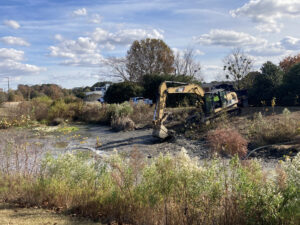
Position available: Stormwater Education Coordinator
April 18th 2024
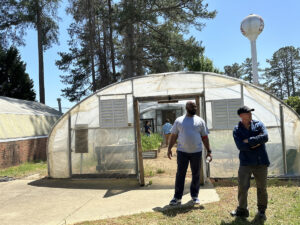
Southern Nash next in line for stormwater projects
April 18th 2024
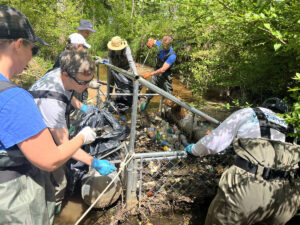
Xylem, Sound Rivers team up for cleanup
April 18th 2024

Sound Rivers launches new podcast
April 18th 2024

Swim Guide gearing up for a seventh season
April 11th 2024
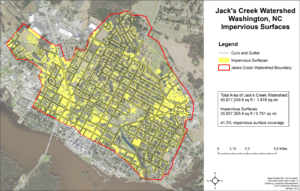
Feedback needed for Jack’s Creek plans, projects
April 11th 2024

Pamlico-Tar Riverkeeper talks water quality
April 11th 2024
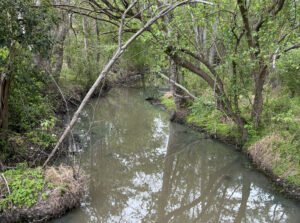
Pamlico-Tar Riverkeeper investigates Maple Branch turbidity
April 11th 2024

